by Rick O'Connor | Feb 28, 2017

Torpedo grass. Photo credit: Rick O’Connor.
They say the best time to attack an invasive species is early in its arrival. In the early stages is your best chance, using the most cost effective methods, of eradicating an invasive species from a region. Hence our focus on Early Detection Rapid Response (EDRR) list. That is not the case with Torpedo Grass. It is now found in all Gulf coast states and along the Atlantic border to North Carolina. In Florida, it has been reported from 64 of the 67 counties and has also been reported in California and Hawaii. However, it is a problem plant and property owners should try to manage it as best they can.
There is a discussion as to the origins of torpedo grass (Panicum repens). Some say Europe, others Australia, but we do know it is not native to the United States. It was first introduced here in the late 19th century as a forage grass for livestock. Being a tropical-subtropical plant, the introduction was in the southeastern U.S. The young shoots have been selected by forging mammals, livestock and otherwise, but older plants become tough and the livestock ignore them for other species. There are reports of waterfowl and songbirds using torpedo grass as habitat. However, the cons out weigh the pros on this one.
Torpedo grass grows very quickly using underground rhizomes. Though they do produce seeds, these rhizomes, and their fragments, are the primary method of propagation for this plant. It has been found that rhizomes buried as deep as 20 inches can sprout shoots. This aggressive plant spreads quickly, outcompeting native grasses in disturbed areas. They will displace forage grasses that livestock prefer and can inundate a pasture very quickly. Though it is drought tolerant, torpedo grass prefers moist soils and can grow in water as deep as 6 feet. Many property owners have used this grass to control shore erosion but here is where it has causes problems for others. As on land, it grows very quickly. Spreading across shallow waterways making them unnavigable. It has caused problems with irrigation systems, stream flow, and flood control in some areas. It has also invaded citrus groves and gold courses.
So how do we deal with this plant if it is on our property?

Torpedo Grass Photo Credit: Graves Lovell, Alabama Department of Conservation & Natural Resources, www.bugwood.org
Well, we know it is not a fan of cold weather, but we are in Florida; even north Florida is suitable for it. We know it will not survive extreme hot periods. We can only hope that it will get warm enough to knock back large acres of this thing; but warm temperatures like this are not good for most plants in our area – or animals for that matter. There are no known biological controls at this time. So that means we turn to herbicides.
Experience has shown that herbicides alone will knock it back, but rarely eradicates it from the area. Chemicals that have had success are glyphosate and imazapryl. In both cases, an aquatically registered surfactant may be needed for good results. When the torpedo grass is in water, herbicide treatment can be a problem. First, the chemicals used are non-selective and may kill plants you do not want to lose. Second, mats of dead torpedo grass have been known to decrease dissolved oxygen levels (due to decomposition) to levels where fish kills can occur. Some studies have found that burning a field of torpedo grass and then treating with both glyphosate and imazapryl has had some success. Treating first and then burning has not been as successful, nor has leaving one of the three out of the program.
As common and aggressive as this grass is, you may feel any attempt to control is feudal, but doing nothing can be very costly as well. We recommend properties with patches of this grass begin treatments soon, and if you have very little – remove as soon as you can. To learn more visit one of the following websites:
Torpedo grass in Aquatic Environments
Torpedo grass Management in Turf
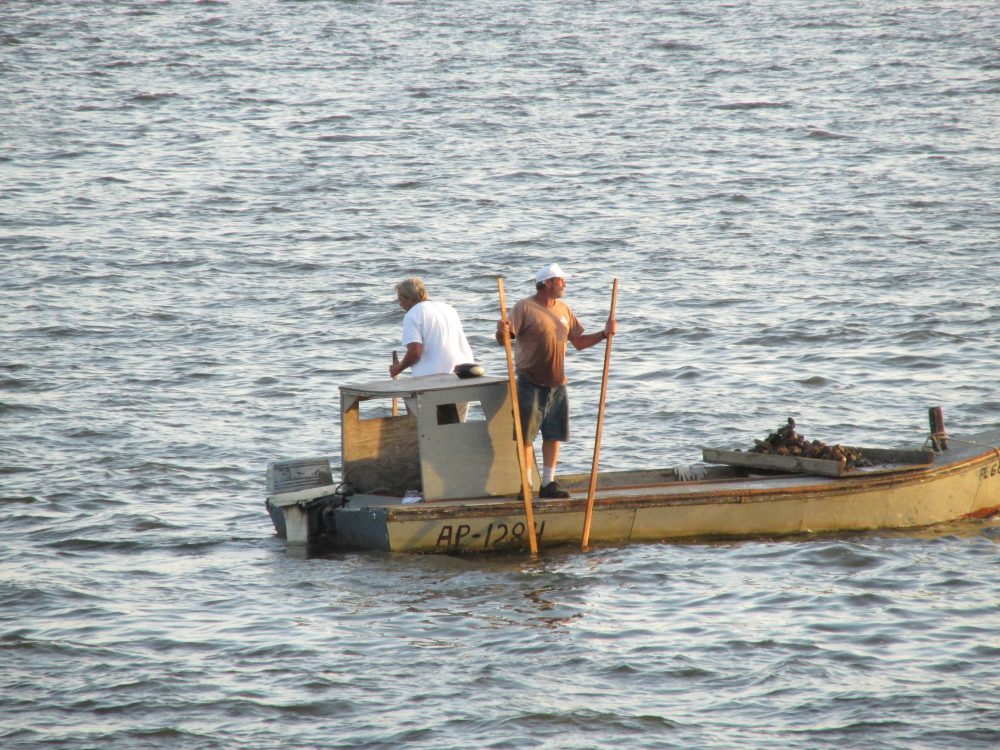
by Rick O'Connor | Feb 18, 2017
In his 137-page report to the U.S. Supreme Court published on Valentine’s Day, a Special Master appointed to oversee the case has stated, “Because Florida has not met its burden, I recommend that the court deny Florida’s request for relief.” This may not be the final word on the matter but it does sound like the “bottom line” as the highest court in the land will lean heavy on his recommendation when they rule on the case in the days to come. So, will this be the end of the decades-long battle over water rights in the Apalachicola-Chattahoochee-Flint River Basin? Considering the magnitude of what is at stake when it comes to this “Dixie-Style” water war, I seriously doubt it.
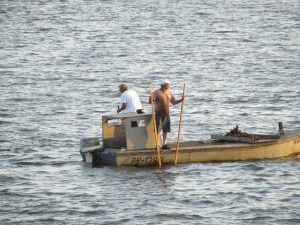
Hard working Apalachicola oystermen are finding times tougher with the “water wars” problem.
Photo: Erik Lovestrand
Florida argued for years that Georgia was illegally using water from its reservoir in Lake Lanier for unauthorized purposes according to the legislation that allowed the dam to be built in the first place. When that argument fell through during prior court rulings, the state sued claiming harm to the once prolific oyster fishery in Apalachicola Bay that has sustained a near total collapse that began in 2012. Florida contended that reduced freshwater flows tied to increased human needs upstream and sustained drought in the southeast had resulted in higher average salinities in the Bay, which added stressors (disease, parasites and predators), causing the crash.
Proponents of Florida’s case were ecstatic when the highest court in the land agreed to hear this case, following denials to do so in the past. Proponents on Georgia’s side of the case claimed that there was no proof that reduced flows had caused the crash and instead blamed poor management of the fishery for Florida’s woes.
Special Master Ralph Lancaster largely agreed with Florida’s assertions on the cause of the fishery disaster but still ruled against Florida’s request for relief saying that the evidence based on low flows during drought periods did not prove how a cap on Georgia’s water use during other times would provide the relief requested. Special Master Lancaster also hinted that Florida had made a grave mistake in not naming the Corps of Engineers as a party in this dispute. He said “Because the Corps is not a party, no decree entered by this court can mandate any change in the Corps’ operations in the basin.”
Georgia officials are breathing a sigh of relief as the economic impact to their state would have been substantial if this had not gone their way. On the other side of Lake Seminole at the State line, Florida’s resource managers still worry about what they can do to improve conditions in a struggling estuary on the Gulf Coast, once known locally as the “Oyster Capital of the World.”

by Rick O'Connor | Feb 18, 2017
It was February 13, 2017 and the temperature was 74°F… 74! It has been one strange winter. The azaleas in my yard have already bloomed, friends of mine have seen butterflies already forming chrysalis, and I have already had to deal with mosquitos; all of this in February. But, even as we talk about how warm this winter has been in the panhandle, they are having record snowfall in the Midwest and Northeast. It has been a strange winter.
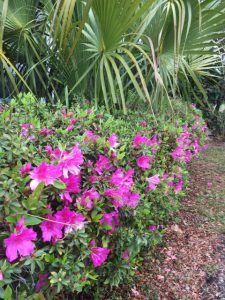
Azaleas typically bloom near Easter. These bloomed in mid-February in 2017.
Photo: Rick O’Connor
It is easy to change this discussion to climate change, but we have had weird winters before. There was the winter when George Washington crossed the Delaware, apparently colder than normal for that part of the country that year. I remember as a kid having to wear a heavy coat to school in the winter and frost was on the ground most mornings – I grew up in the panhandle by the way.
In the book Sea Level Rise in Florida; Science, Impacts, and Options, Dr. Albert Hine (University of South Florida) explains why these periodic cold and warm years occur. Our orbit around the sun is not a perfect circle; the elliptical path can adjust our distance and change the amount of solar radiation we receive from Mother Sun. Then there is the wobble effect. The rotation of the Earth on its axis is similar to a spinning top, and the wobble can alter the amount of solar radiation we receive. These orbits and rotations explain the ice age and warm periods have experienced, and Dr. HIne provides geologic evidence that supports these climate change periods. The weird thing is, based on our current orbit/rotation pattern we should be in a cooling period and heading towards an ice age. But we are not, actually the last three years have been the warmest on record. So, if the stars say we should be heading towards a cooling period, and it is warming, the question begs – why?
Well, Dr. Hine suggest that it must be our activities. Man has made so many changes that have affected our planet in so many ways that some are saying we are in a period of the Earth’s history they are calling “Anthropocene”. It is hard to argue with it. Look out your window next time you are flying and see how we have changed the landscape. You cannot see these changes as you fly over the ocean, but the changes are there. Warm surface water usually overrides cooler waters at depth. The circulation of warm and cold water due to differences in density cause the currents, which cause the wind patterns, which effects our climate. The ocean is a great absorber of heat, and it is doing just that – absorbing heat, which is now reaching deeper depths. This will certainly effect the currents and the climate. Most will point at the use of fossil fuels as the change that has had the biggest impact on all of this.
So, if this is the case, what do we do about it?
Well there are models predicting what the future climate and sea levels might be, based on potential use of resources. There is nothing, at the moment, that suggest we are going to do anything different in how we use these resources so we can expect these climate changes to continue. Will 2017 follow the current trend and become the warmest year on record yet? Will flowering plants alter their cycles based on temperatures? Are rainfall patterns going to change? Will tropical species, including invasive ones, be able to colonize north Florida? I am not sure, but I think we should consider these possibilities as we plan for our future use of the landscape. Until then, we should enjoy the nice February we are having, and hope July and August are not too bad. We will see what next year brings.
If you are interested in reading more about the science of Florida’s climate, I recommend reading
Seal Level Rise in Florida; Science, Impacts, and Options. Hines, Chambers, Clayton, Hafen, and Mitchum. 2016. University Press of Florida. ISBN 9780813062891.
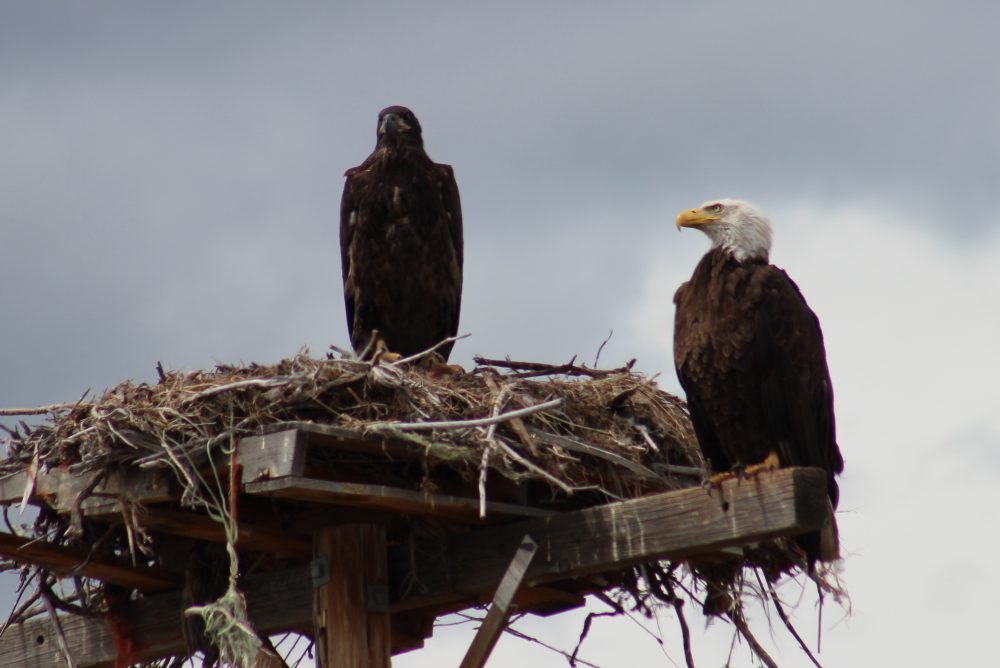
by Rick O'Connor | Jan 27, 2017
After Hurricane Ivan devastated the Pensacola area in 2004, my son was working to repair docks in local waterways. One day, after working on a project in Bayou Texar (near Pensacola Bay), he came by our house and said that he had seen a bald eagle fly over. My wife and I both responded with amazement but at the same time were thinking… “Yea right”. A few days later, we were sitting on the back porch (we live near Bayou Texar) and glancing up we saw a huge bird flying over… you guessed it… a bald eagle. We both looked at each other and just shook our heads saying “did you just see?… yep, that was a bald eagle”. It was totally cool!
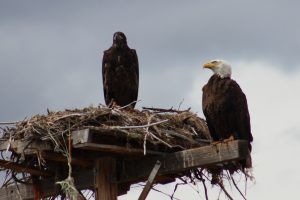
An adult and juvenile bald eagle on nest in Montana.
Photo: Molly O’Connor
In the 1970’s I worked for a local chemical plant on Escambia Bay that had a bird sanctuary on the property. Occasionally a bald eagle would appear during the winter months but it was not annually, and it was a real treat to see it. However, since Ivan sightings in the panhandle have become quite common. Folks are seeing them over Pensacola Bay, Perdido Bay, Garcon area of Santa Rosa County, Gulf Breeze peninsula, almost everywhere! I actually saw three flying together over Big Sabine on Pensacola Beach recently. They are actually now nesting in the area.
These are large birds, 30-40” long with a 7-8 feet wing span, and hard to misidentify – everyone knows a bald eagle. However, the juveniles do not have the distinct white head and tail or the brilliant yellow beak. Rather they are dark brown with possible white spots on their wings, and the beak is darker. The mature color change occurs in 5-6 years. Their diet is mostly fish but they will take small birds and mammals. They are also scavengers, including road-kill, and will “pirate” captured food from other birds. Observations support that ospreys and bald eagles do not really get along.
Bald eagles tend to migrate between their breeding grounds in Canada and those of the Gulf Coast. The migrants are typically non-breeding individuals. Breeding ones tend to remain in their breeding areas year round. As of 2014, Florida has the highest densities of southern breeding populations in the lower 48 states, about 1500 nests. Most return to Florida in the fall for nest building. Their nests are typically in forested areas near waterways. They prefer the tallest trees. The nests are quite large; the record in Florida was 9.5 feet in diameter. They typically lay one clutch of 1-3 eggs but may lay a second clutch if the first is unsuccessful. The young remain in the nests until they can fly – usually April or May. Wintertime is a good time to view these animals in our area.
Their numbers plummeted for a variety of reasons, including the introduction of DDT, and they were placed on the U.S. Fish and Wildlife Endangered Species list. DDT was banned in 1972 and listing them on the ESL protected from them from poaching; they have since recovered. Today they are no longer on the Endangered Species list and were removed from the Florida Fish and Wildlife Conservation Commissions (FWC) imperiled species list. However, they are still protected federally by the Bald / Golden Eagle Protection Act and the Migratory Bird Protection Act; they are also protected in Florida by state law.
Potential viewing locations can be found on FWC’s bald eagles nest location site. https://public.myfwc.com/FWRI/EagleNests/nestlocator.aspx
This site provides known locations between 2012 and 2014. Recent surveys were conducted between 2015 and 2016 in several panhandle counties but those locations have not been posted yet. For those in the Pensacola area, there are four permanently injured bald eagles at the Wildlife Sanctuary of Northwest Florida. The public is welcome to visit the sanctuary Wednesday through Saturday from 12:00 – 3:30PM (self-guided).
105 North S Street, Pensacola FL 32505
http://www.pensacolawildlife.com/
For more information:
http://myfwc.com/wildlifehabitats/managed/bald-eagle/information/
http://myfwc.com/wildlifehabitats/profiles/birds/raptors-and-vultures/bald-eagle/
http://myfwc.com/wildlifehabitats/managed/bald-eagle/faqs/

by Rick O'Connor | Dec 16, 2016

The Florida Orange Sea Star.
Photo: Florida Sea Grant
One of the more popular traditions this time of year is placing the star on top of the Christmas Tree. The star represents the Christmas Star which led the wise men to the manager. The stars that have been placed on Christmas Trees over the decades have come in all shapes and forms but gulf coast residents will use a starfish to both represent the Nativity and their connection to the sea.
Starfish, more correctly called sea stars, are one of the most recognized marine creatures in the world. Many have used it as a logo or their symbol of the sea. But what is a sea star actually? We know they live on the bottom and look like stars but what do they do? How do they function?
Sea stars are invertebrates in the Phylum Echinodermata. Echinoderms have radial symmetry; meaning they have a distinct top and bottom but no head or tail. You certainly know if it is upside down but you are not sure if it is facing you. They are the only invertebrates to have an internal skeleton; called a test. It is this skeleton we find in the curio shops and stores – and what we place on our tree. This skeleton produces tubercules or spines which extend into (and above) the skin – giving them the “spiny skin” for which they get their name – “echino” “derm”. Echinoderms have a series of tube like sacs underneath their bodies which they fill with water and use like suction cups to move and feed. Most have male and females and all produce planktonic larva.
Sea stars in particular are found worldwide and are more common in coastal waters. They come in a variety of colors and most have five arms – though one species has 40! Their mouth is on the underside of the body and lacks teeth. They have a pigment spot at the end of each arm that can detect light. Some sea stars are attracted to light, while others are repelled by it. Most sea stars are carnivorous, feeding on a variety of invertebrates including other echinoderms, and some are scavengers. Mollusk are a common prey, and – to the dismay of oyster farmers – oysters are an easy prey. The sea stars approach the bivalve, use their tube feet to open the two shells slightly, and insert their digestive tract inside the oyster. They attack the abductor muscle first, release the tension on the two shells, and then consume the rest of the animal. Sea stars like seawater, so oysters growing in the upper estuaries have fewer problems with these predators. Our local sea stars are good at detecting buried prey in our quartz sand and then digging them out. These animals are famous for their ability to regenerate their body parts. Oyster farmers trying to reduce this threat have been known to cut them and toss them back, only to have more sea stars later. However sexual reproduction is also very common. Most sea stars have 2 gonads per arm and can fertilize up to 2 million eggs in a spawning event. Spawning is usually in the spring and is triggered by chemicals in the water.
Though they are a classic icon for the ocean, and holiday decoration along the coast, these are fascinating animals in their own right. I wish all of you Happy Holidays and a joyous new year.










